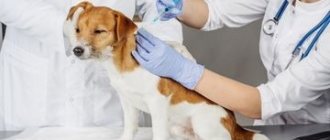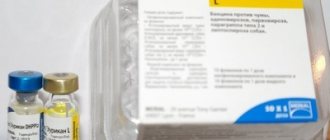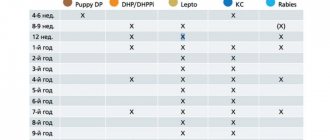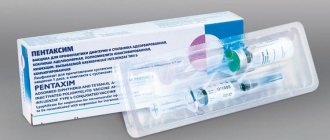Vaccination protects against infections that can lead to the death of the animal. These include several diseases, in particular rabies and leptospirosis, which are also dangerous to humans. But the dog owner does not always have the opportunity to visit a veterinary clinic. In such cases, you need to know how to vaccinate a dog yourselfto protect it from dangerous viruses and bacteria.
Vaccinations protect against rabies and other infections
Vaccination schedule
Vaccination is carried out according to a specific schedule.
Table 1. Recommended vaccination schedule for dogs
| 8-9 weeks | Vaccination against canine distemper, parvovirus enteritis, infectious hepatitis, adenovirus infection, parainfluenza, leptospirosis. |
| 12 weeks | Revaccination against canine distemper, parvovirus enteritis, infectious hepatitis, adenovirus infection, parainfluenza, leptospirosis, rabies. |
| After changing teeth | Vaccination against canine distemper, parvovirus enteritis, infectious hepatitis, adenovirus infection, parainfluenza, leptospirosis, rabies. |
| 1 year | Vaccination against canine distemper, parvovirus enteritis, infectious hepatitis, adenovirus infection, parainfluenza, leptospirosis, rabies. |
| Annually | Revaccination (canine distemper, parvovirus enteritis, infectious hepatitis, adenovirus infection, parainfluenza, leptospirosis, rabies). |
Attention! Some manufacturers produce vaccines that guarantee protection of the animal from viruses and infections for 3 years. Accordingly, they are administered once every 3 years.
Vaccination is carried out according to a specific schedule
In Russia, dogs are vaccinated against borreliosis and bordetellosis, the causative agents of tracheobronchitis (CB). Whether they are needed is decided by the doctor based on data on the epidemiological situation in the region.

The most common and dangerous diseases that dogs can get
The disadvantage of vaccinations at home is that this fact is not noted in documents - veterinary passports and specialized registers. Therefore, if we are talking about an animal that will travel or take part in exhibitions, then the procedure is carried out in a veterinary clinic. Previously, according to the law, rabies vaccinations were allowed only in government clinics. Now private veterinary clinics are also given such powers.
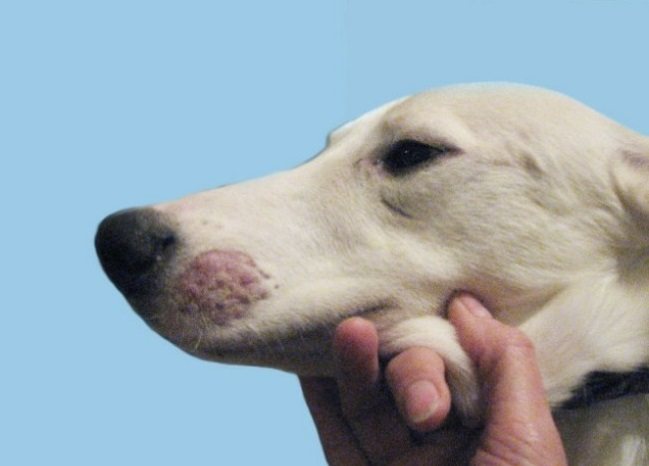
It has not been proven that vaccination can protect a dog from shingles.
Dogs are also vaccinated against other diseases - parasitic infestations, coronavirus, lichen. But their effectiveness is either low or not proven.
Attention! When choosing a drug, remember its name and manufacturer. Veterinarians recommend vaccinating an animal with the same vaccine throughout its life.
What vaccinations does a puppy need?
The standard vaccination complex provides protection against diseases such as:
- Carré's disease (canine plague) is a contagious viral disease that affects the nervous system. It is difficult for small puppies to tolerate and leads to death in 80% of cases;
- Rabies is dangerous for all warm-blooded animals, including humans. Cannot be treated. The infected animal must be euthanized, or death occurs on its own within 5 days;
- Parvovirus enteritis is a highly contagious viral disease, especially dangerous for young dogs under 12 months, the fragile organism dies in 95% of cases;
- Leptospirosis - jaundice, instantly affects the liver. Dangerous to humans, it spreads very quickly. In most cases it leads to the death of the animal;
- Infectious hepatitis - can lead to blindness and liver dystrophy; with fulminant hepatitis (more common in puppies), death occurs within 2 days; the virus is transmitted by contact.
Additionally, veterinary clinics offer vaccinations against:
- Piroplasmosis;
- Depriving;
- Parainfluenza;
- Adenovirus.
Also, depending on the region of residence and the number of epidemics in the area, the doctor may recommend additional immunization.
You should not ignore the veterinarian’s recommendations; he has information about the increasing incidence of diseases and will help prevent possible infection.
Vaccination table for puppies in their first year of life
| Age | Diseases | Notes |
| 8 – 12 weeks |
| First vaccination |
| 11 – 15 weeks |
| Revaccination |
| 11 – 15 weeks |
| The first immunization, if the puppy is kept in a greenhouse, can be postponed until the change of teeth |
| 9– 12 months |
| Last puppy vaccination, next in a year |
| 9 – 12 months |
| Last puppy vaccination, next one in a year |
All data entered in the table is approximate and may change based on living conditions, viruses attacking in a particular region and the puppy’s health condition.
Primary vaccination
Primary vaccination is recommended to be carried out at the dog owner's home. To avoid contact of the puppy with sick animals in the clinic. Immunization is carried out only for completely healthy pets, and upon contact with potential carriers of infections in a veterinary institution, this condition may be interrupted.
Revaccination
It is proposed to do a double vaccination, also with a veterinarian visiting your home . Until the puppy’s immunity is fully formed, contact with animals in the hospital should be avoided, because it is unknown what disease carriers come there. Moreover, having a doctor come to your place of residence will relieve the puppy of additional stress.
Vaccines
In veterinary practice, the following brands of vaccines are used to vaccinate dogs:
- Nobivac;
- Duramun;
- Eurikan;
- Biovac;
- Dipentavak;
- Asterion;
- Multikan and others.
Basically, these are complex products that contain causative agents of major infections, some of them including the rabies virus. The latter include Asterion DHPPiR, Multikan-8.
Attention! Not all domestic vaccines are recognized abroad. Therefore, it is necessary to consult a veterinarian about the drug if you are planning a trip accompanied by an animal.
Decoding the letter values in the names of the product
Vaccines are either live or inactivated. Not all specialists use inactivated products. According to some doctors, they provide weaker immune protection, so preference should be given to “live” formulations.
How the vaccine is administered
It is better to get vaccinated in the morning on a day off. This makes it possible to monitor the dog’s condition all day long.
You can read about how to prepare your dog for vaccination, what to do if complications arise and where is the best place to vaccinate in our article.
Typically, the kit includes two products: the vaccine itself in powder form and a solvent for it. The components are first mixed. To do this, draw up the solvent with a syringe, and then inject it with a needle through the lid into the container with the powder. The mixture is thoroughly shaken until all dry particles are dissolved. Select the injection site:
- subcutaneously - withers area;
- intramuscularly - thigh area.
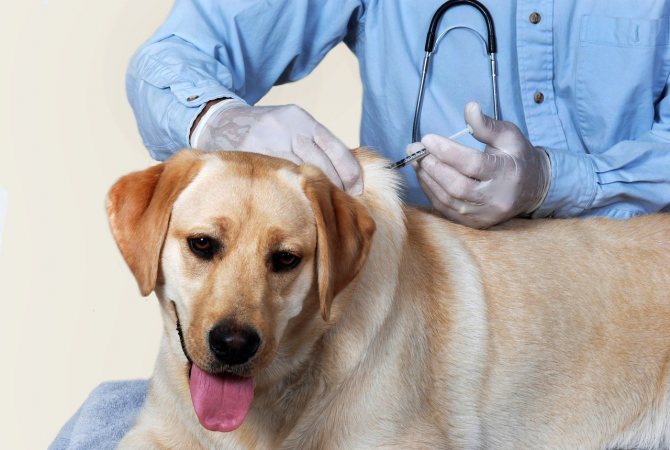
Place of injection - withers area
Next, the drug is administered into the dog’s body in the following order:
- treat the injection site (if necessary, cut it with scissors);
- wipe the injection site with medical alcohol;
- immobilize the animal using a special bag, towel, or ask another family member to hold it;
- if the injection is given at the withers, a fold of skin is collected on this part, into the base of which a needle is inserted;
- the drug is infused;
- remove the syringe;
- wipe the injection site with alcohol.
The instructions for some drugs say that the injection site must be massaged. More precise instructions regarding the rules and method of administration should be sought in the manufacturer's instructions.
Intranasal vaccines (for example, Nobivac KS) are administered into the nostril. Then the drug is poured into the nasal passage.
Video - How the vaccine is administered
The vaccine should not be used in the following cases:
- bottles or caps are damaged;
- the product has expired;
- the liquid or powder looks different from the description in the instructions.
Personal safety measures
The vaccine spilled on the body is washed off with plenty of running water. If a veterinary drug is accidentally administered to a person, then in such cases, immediately consult a doctor. The specialist is presented with a factory-made vaccine bottle.
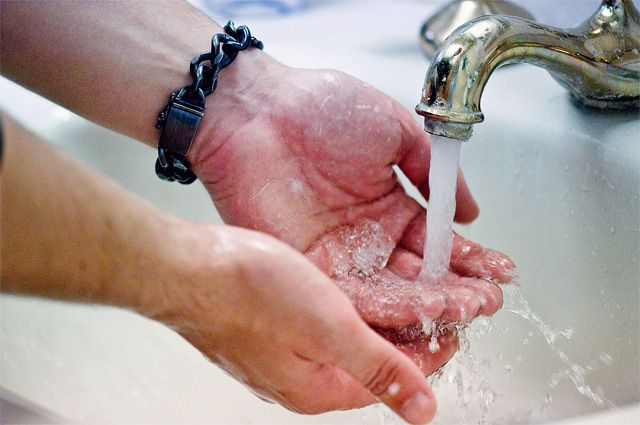
Any drug that gets on the skin is washed off with plenty of running water.
The drugs are stored in places inaccessible to children. After use, the product is immediately discarded so as to prevent other animals or people from reaching the containers and used syringes.
First vaccination
The first vaccine is administered twice, regardless of the dog’s age, according to the following scheme:
- Anthelmintic drug - 2 times with an interval of 2 weeks.
- The first vaccination is after 1.5-2 weeks of the second dose of anthelmintic.
- The second vaccination is 3 weeks after the first.
Attention! Re-vaccination is carried out with the same drug with the same quantity and qualitative composition of strains. Using another drug may be dangerous to your pet's health.
Contraindications to vaccination
Vaccinations are given when the dog is healthy. This is important because vaccination puts a strain on the immune system. The body must respond correctly to the substance and fully produce antibodies.
Vaccinations are prohibited for dogs with the following conditions:
- infection with worms;
- illness, including one suffered shortly before;
- exhaustion;
- change of teeth in a puppy.
Also, you cannot plan to administer the vaccine 2 weeks before and after the cupping procedure.
Attention! The body must first be cleared of worms. Dogs are given medications two weeks before vaccination. Parasites reduce the effectiveness of the drug to zero.
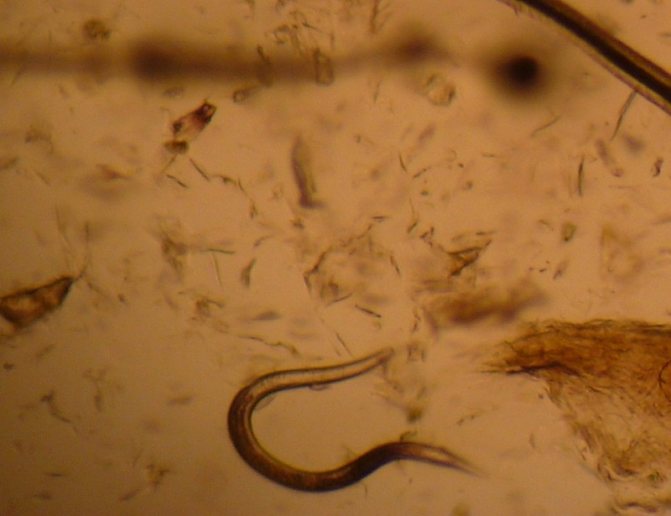
Parasites are expelled before vaccination
Another contraindication is previous vaccination. The next one can be carried out no earlier than after 3 weeks.
If on the day of vaccination or one or two days before, the owner notices alarming symptoms in the pet, digestive disorders, changes in behavior, the procedure is postponed.
How to prepare your dog for vaccination
Vaccination is a rather serious procedure for which you should prepare. To do this you need:
- 2-3 weeks before the scheduled date, carry out deworming;
- “forget” about walks to avoid contact with any dogs;
- 5 – 7 days before the visit to the doctor, monitor the condition of the four-legged animal;
- do not feed the dog before vaccination (3.5 – 4 hours);
- if the pet is afraid, it is better to be nearby, pet it and talk to it.
Deworming – treatment against internal parasites. They give deworming tablets, which can be purchased at a veterinary pharmacy. The body must be completely “cleansed” of worms and other parasites.
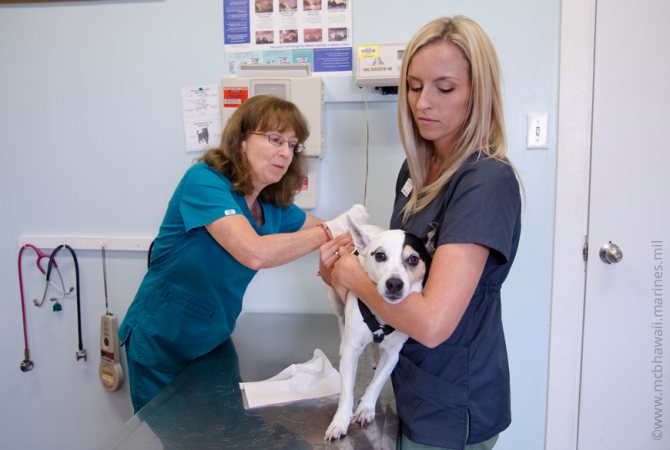
Pregnancy and lactation
It is recommended that your dog be vaccinated before pregnancy occurs. It is possible that vaccine components can penetrate the placenta and cause fetal death or developmental defects. If such a measure is necessary, it is recommended to use only inactivated drugs, which are selected by the veterinarian.
It makes no sense to vaccinate a nursing bitch to protect the offspring. In order for puppies to acquire passive immunity, the female’s body must begin to produce antibodies. To do this, at least a week must pass after the procedure. Antibodies are obtained from the mother through colostrum in the first 36 hours of the offspring's life.
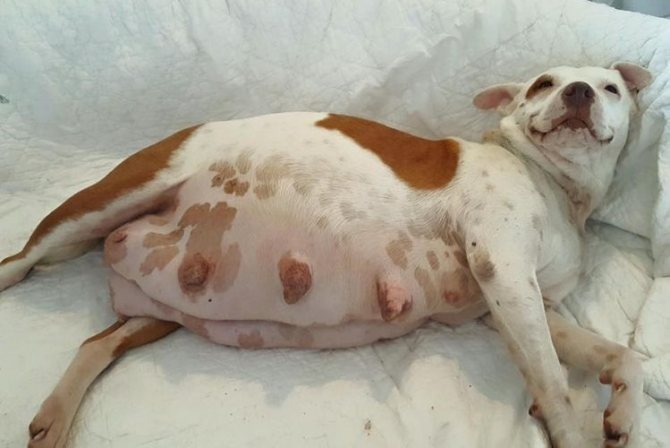
It is better to vaccinate a bitch before pregnancy.
Conditions for preparing for vaccination
Before you vaccinate your dog, it needs to be prepared for it. The main condition for successful vaccination is the absolute health of the pet. Therefore, a medical examination is required before vaccination. If the animal is unwell or weakened due to childbirth, surgery, or injury, then the vaccination dates will be postponed. It is equally important to observe the following points before vaccination:
- A week before vaccination, your pet must be rid of all parasites - fleas, ticks, and especially worms. The presence of parasites or poor health significantly weakens the dog’s immune system, so the vaccine may simply “not work.” You can deworm your dog with drugs such as Drontal, Dekaris or Vermox; the dose is calculated depending on the weight of the animal. If there are other dogs at home, then for prevention purposes they are dewormed too;
- Puppies should not be walked before their first vaccination. But if you can’t wait to do this, then you can take him outside for a while in your arms, but in no case lower him to the ground;
- If digestive disorders appear, or the dog looks lethargic and cheerless, refuses to eat, then before vaccination, you must inform your doctor about this. It is also necessary to warn if the dog is prone to allergies.
Pregnant bitches are vaccinated with caution, as there is an opinion that live strains of viruses can penetrate the placenta and negatively affect the embryos. But vaccines with killed pathogens have been tested and can be used if there is an urgent need. Estrus is not a contraindication to vaccination, since it is a physiological process.

Features of puppy vaccination
Puppies that are breastfed acquire passive immunity from their mother, provided that she is vaccinated in a timely manner. The female passes antibodies to infections to the cubs with her milk. The time of the first vaccination depends on the quality of the mother's lactation. If there are few puppies, then vaccination is carried out no earlier than 10 weeks. Earlier introduction of complementary foods and a large litter are grounds for vaccination at an earlier age.

Puppies receive passive immunity from their vaccinated mother
Vaccinations for dogs by age
The puppy is taken from its mother at one month or a little later. Then they are also protected by maternal immunity, passed on from the dog - the mother.
Note that immunity will only apply to those infections against which the mother’s body was vaccinated or with which she was ill not so long ago. There are diseases that leave protection for life, but their intensity is not very strong and will not fully protect the baby.
When to vaccinate dogs is a controversial issue. After all, the age of the baby’s first procedure depends on a lot of risk factors and the time when he was taken from his mother. Approximately 3-4 weeks after weaning, the level of mother’s antibodies in the puppy’s blood decreases significantly - then the first vaccinations are given to the dog. It is undesirable to administer the vaccine earlier, because the animal’s immunity has not yet adapted to the production of its own antibodies and cannot yet provide strong protection.
Injections should only be given at four weeks of age when there is a risk of infection or disease. In this case, veterinarians advise vaccinating dogs with gentle “puppy” injections. It is also not recommended to vaccinate puppies at a late age, because it is necessary to do so before the change of baby teeth.
Monitoring the dog's condition
After vaccination, it is necessary to monitor the animal’s condition for 2 weeks.

Some discomfort is considered normal
The following phenomena are considered normal:
- A lump or lump in the place where the drug was injected. The formation resolves within a month. If the lump increases in size, then this is a reason to consult a doctor.
- Vomiting, diarrhea, refusal to eat, if these phenomena were recorded once.
- Pain at the injection site.
- Lethargy, fever up to 39 °C.
So how long should it take to vaccinate a dog?
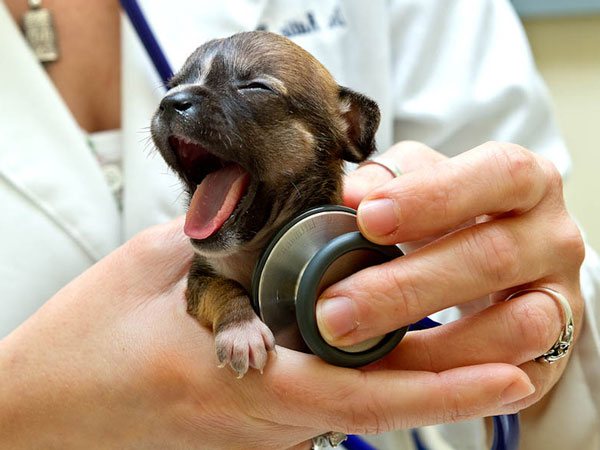
Photo from the site https://dad-master.ru
Traditionally, puppies are vaccinated from the age of eight weeks. In this case, at two months (eight to ten weeks) a complex injection is given, and after twenty-one days a revaccination follows. At the same time they are vaccinated against rabies (age eleven to thirteen weeks). When the milk teeth are finally replaced by molars, a complex injection is given. Then they are revaccinated annually with a polyvalent vaccine and a monovalent rabies injection.
If we talk about how often dogs are vaccinated, you will notice that after scheduled injections for up to a year, repeated vaccinations occur annually.
Owners often ask: where do dogs get vaccinated? Pets are vaccinated at the withers or hip. Animals have a large number of blood vessels there.
Complications from vaccination
You should immediately contact your veterinarian in the following cases:
- loose stools and vomiting after administration of the drug were observed 2 or more times;
- the dog missed more than one meal;
- temperature above 39 °C;
- convulsions and drooling appeared;
- mucous membranes turned pale;
- swelling is noticeable;
- breathing became difficult and quickened.
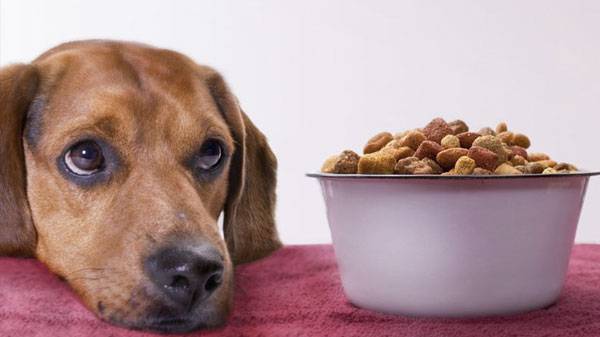
Prolonged refusal to eat is a cause for concern
A painful reaction is provoked by various factors. Poor quality vaccine is one of them.
Allergy to the drug
An acute attack of allergy is observed in a dog 10–15 minutes after administration of the drug. This is the most dangerous reaction to the vaccine. The following symptoms may occur:
- behavior is disrupted - the animal becomes too excited or depressed;
- head temperature rises;
- the dog may suddenly relieve itself;
- the muzzle swells - eyes, nose, ears;
- saliva is produced abundantly;
- watery eyes or nasal discharge appears.
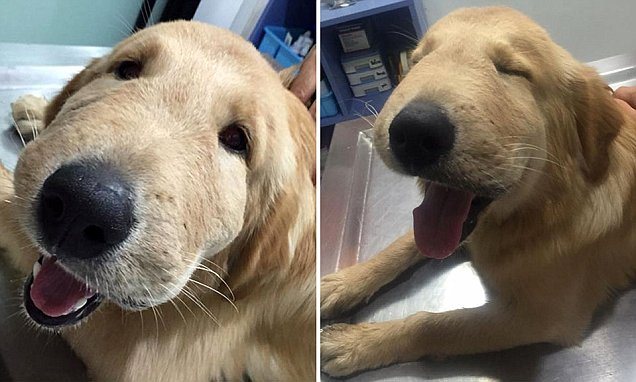
After administration of the drug, an acute allergic reaction is possible
You should always be prepared for such a reaction. Therefore, it is a good idea to ask your veterinarian which drug and in what dose should be administered in such cases. For severe allergies, solutions of Tavegil, Andrenalin or Suprastin are used. In case of anaphylactic shock, Dexamethasone is recommended, after which the pet is immediately shown to a doctor.
Video - Complication in a kitten after vaccination
To avoid an allergic reaction, the solution is administered fractionally: first a small dose, then the remaining drug in the syringe. Then the antibodies bind to a smaller portion of the solution, thereby reducing the severity of the reaction.
Restrictions after vaccination: walking, swimming, etc.
Every puppy has what is called an immune gap period. It lasts 2 weeks. This is the time between when the antibodies obtained from mother's milk stop acting and before the formation of one's own protective forces after the first vaccination.
During this period, the risk of infection remains high. Therefore, a quarantine is introduced for 2 weeks, during which it is prohibited:
- take him outside;
- contact with other animals;
- underfeed or overfeed;
- overload the dog;
- wash the dog (bathing is allowed no earlier than 3 days after the manipulation);
Also avoid hypothermia, overheating, being in drafts or stuffy rooms.
You can cheat a little about walking. If the dog lives in a private house with a fenced area, he is allowed to go out into the yard or onto the lawn after just a few days.

Walking within the city is also not strictly prohibited. The main thing is to avoid contaminated places, not to contact other animals and carry the baby in your arms to clean clearings.
The choice of whether and when to walk the puppy remains with the owner. It is not recommended to carry the baby because his immune system is weakened after vaccination. But he also needs to be accustomed to the street, relieve himself outside the home and socialized.
Quarantine after the vaccine
After receiving the vaccine, the dog is kept in quarantine for 10–14 days to develop lasting immunity. They don’t refuse walks. But their duration is reduced to the minimum necessary, especially in unfavorable weather conditions, in order to prevent hypothermia. They try to exclude contacts with other animals, in particular stray ones. Physical activity is also limited.

Don't miss a walk during quarantine
Types of vaccinations for dogs: to give or not
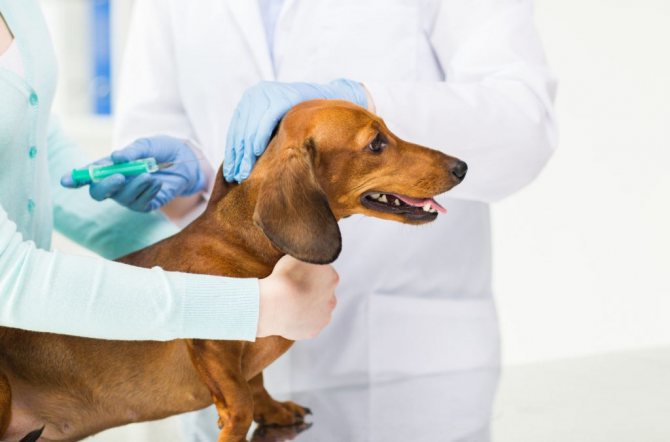
Photo from the site https://vetklinikaspb.ru
There are two types of vaccines known in veterinary medicine: live attenuated and non-live. The latter cannot cause discomfort even in sick dogs, for this reason such intervention is considered safe. But immune protection is not durable and strong, which cannot be said about a live vaccine.
Therefore, vaccines with active microorganisms are most preferable, but are only possible in completely healthy pets.
Vaccines are also distinguished by the number of antigens used. Thus, there are mono-vaccines (they provide protection against only one pathogen) and complex vaccines (they already contain several pathogens).
Dogs are protected against rabies with a single vaccine.
How to store the vaccine
When purchasing a drug, you must ask the pharmacy seller to provide instructions for it. Optimal storage conditions are indicated there.
Attention! The effectiveness of the procedure depends on whether the recommendations are followed. A vaccine that has been stored without temperature control is unsuitable for use.
Most of these products are stored at a temperature of 2...8 °C. Freezing ampoules is prohibited, since the properties are lost in the same way as when heated. To deliver the drug from the veterinary pharmacy to your home, special thermal container bags are used. Such products are on sale. Some pharmacies rent bags with a deposit. To ensure the safety of the drug, some kind of refrigerant is placed inside - “dry ice”, ice cream, a bottle of frozen water.

Special container bags are used for delivery
A low-quality vaccine is always dangerous. In the “best” case, it will turn out to be plain water without a therapeutic effect. This will not harm the animal, but the body will not receive immunity to the infection. In the worst case, it will cause an allergic reaction and lead to death.
Infection of a vaccinated animal
Vaccination does not provide a 100% guarantee that the vaccinated animal will not get sick. Infection occurs for the following reasons:
- low quality vaccine used;
- the storage conditions of the drug were violated;
- the solution was introduced incorrectly;
- the effect of the vaccine is suppressed by antibodies contained in the mother’s milk;
- there are other diseases, especially those associated with decreased immunity;
- the animal is infected with a large dose of the pathogen, the likelihood of such a scenario increases if this happened during the formation of immunity);
- the disease developed before immunity was formed.
However, such adverse events are rarely recorded.
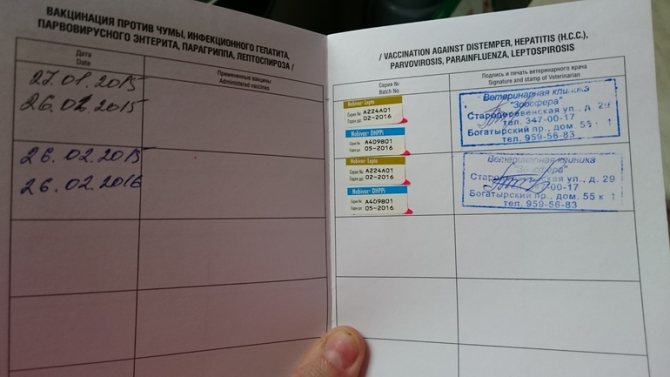
Vaccination notes in the veterinary passport
conclusions
Preparing for vaccination is an important process for both a puppy and an adult dog. The quality of the formed immunity depends on this. Vaccination itself is stressful for the body. Side effects are possible, but with timely help the outcome is good. Parasites in the intestines weaken the animal. The range of anthelmintic drugs is wide. It is possible to vaccinate dogs at home, but only if you have skills in this area. This vaccination is not registered at the state level.
Please follow and like us:
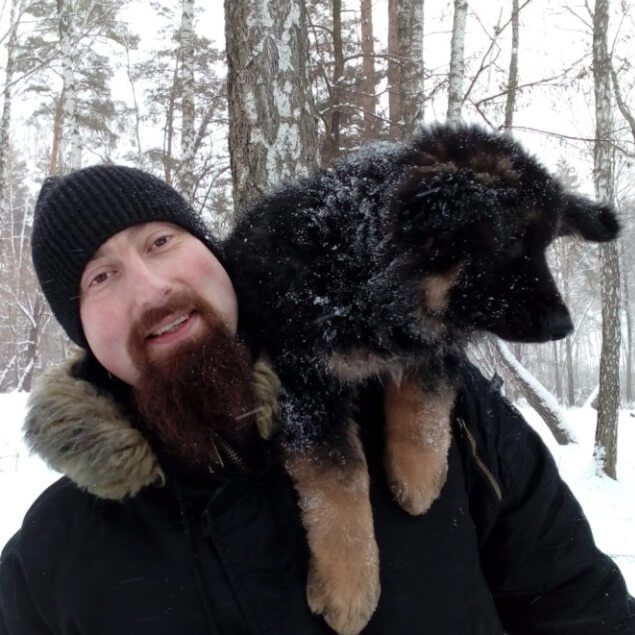
Nikitin Sergey
I write about dogs based on the experience and knowledge gained during my studies as a veterinarian, work in my specialty, and simply from observing my pets.
